| Please access the following URL if you want to secure using SSL. All pages in the site will be secure pages. |
https://secure02.blue.shared-server.net/www.fish-food.co.jp/message english 4.2024.html |
Welcome to FISH FOOD TIMES
Apr. 2024 issue No.244

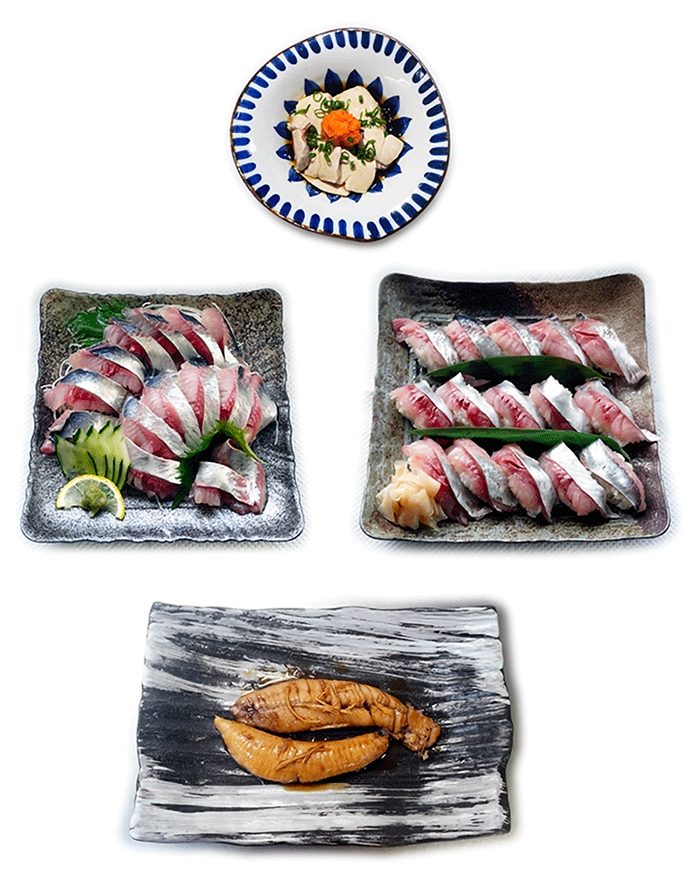
Raw herring
Good catch of herring
As of late March 2024, herring fishing on the Japan Sea side of Hokkaido appears to be going well. The final numbers will be confirmed after the fishing season ends, but although there are differences in good and bad performance by region, the overall average is about a 40% increase over the previous year. Moreover, most of the fish are large, with an average body size of 30 to 32 cm and an average weight of 330 to 480 g, and the average weight of the female ovaries, which are used to make Kazunoko, is often around 100 g when fully ripe.
As of March, transaction prices at the Sapporo Fish Market seem to be hovering around 500 yen/kg for extra-large size fresh fish for females and 200 yen/kg for males, which is not much different from last year. However, the price of fish shipped from Hokkaido across the country appears to be about 30% lower than last year.
Herring, which was once called a mythical fish, has been gradually increasing in catch since a dozen years ago, as shown in the graph below, and this year the trend has become even stronger.
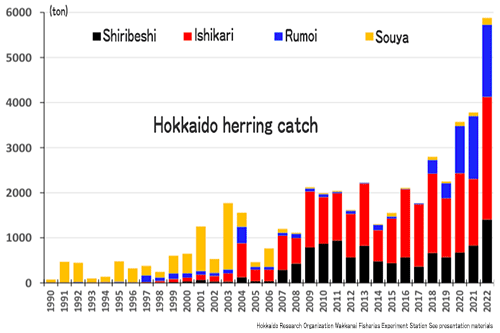
As shown in this graph, herring stocks are steadily recovering year by year, and those involved in seafood retailers should consider that they have already become a must-have item for sale among fresh seafood. This is of course a natural fact in Hokkaido. However, even though processed seafood products such as salted kazunoko and Migaki herring are familiar in areas other than Hokkaido, it seems that it has not yet become commonplace to sell herring as a type of raw fish in stores.
In FISH FOOD TIMES February 2020 issue No. 194, the author wrote the following about the situation in which herring stocks were
It is unclear at this time whether herring catch will return to nearly 1 million tonnes in the past, and a full-fledged herring catch recovery may still be a dream story. However, similarly, the sardine species of the multi-harvest fish species were once called " phantom fish '', but in recent years there have been cases where catching has been revived at a remarkable momentum, and I think it may be that herring has similarly increased in the future. What will happen to herring fishing starting in February of Reiwa 2 and kuki will be seen again this year? If you can see kuki over and over again in Hokkaido, we would like you to focus on fresh shipments instead of freezing or processing migaki herring. In recent years, autumn salmon and saury have been historically unfished, and sales of the fish section have been declining. In the fish section, besides sardines, there is a real desire for merchandise that can be sold at popular prices, so fresh shipment of herring to all parts of the country should lead to reasonable sales. As mentioned earlier, fish landed in Hokkaido can be delivered to the fish section in Okinawa the next day. It would not be impossible to make herring sashimi and sushi available in Okinawa by using the recently advanced freshness management technology. Actually, Hokkaido sardines are also sold as sashimi and sushi in the fish section of Okinawa. I do not deny the product of migaki herring, but should we still value the wisdom of using herring that has been around for a long time as a preserved food? In today's era, there should be appropriate food suggestions. For that reason, by focusing on shipping herring raw, the range of herring's food proposals must be significantly greater. I think honeygiri, which was introduced in this month's issue, is one of the tips to eat delicious herring with many small bones in a raw state. Don't be afraid to try such a simple thing without saying it's a hassle. If you sell products that have been treated this way in advance, customers will surely be pleased. |
|---|
What I wanted to emphasize at this time was that we should strengthen sales of herring, which is showing signs of resource recovery, as an important product in fish stores, just like sardines, which have already recovered as a stable resource. At that time, the project involved disassembling three pieces of herring and proposing the commercialization of Honegiri. However, the product proposals, including sashimi and sushi, were not touched upon, so I couldn't shake the feeling that they were half-hearted. Therefore, this time I would like to take a step further in proposing a product regarding herring, and offer some hints that can further expand the sale of raw herring at the retail level.
High presence in Northern Europe
Approximately 2 million tons of herring are caught every year around the world, and the North Atlantic, Baltic Sea, and North Sea are particularly abundant, so they are caught mostly in these areas. It is said that herring has been commonly eaten for more than 2,000 years, mainly in northern Europe, and countries such as the three Nordic countries, Denmark, Germany, and the Netherlands are the major consuming regions for herring. Herring is processed into smoked, salted, and vinegared foods, including canned salted herring called surströmming, which is famous as the world's stinkiest food because of its strong odor. The image below shows Surströmming, which is mainly produced and consumed in Finland and Sweden.
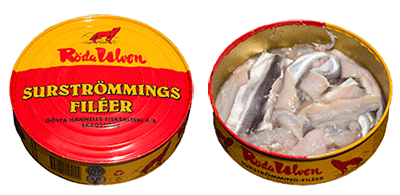
The author visited Helsinki, Finland at the end of October 2017, and would like to briefly introduce the fragmentary facts about herring sales that I saw there, as an example of the status of herring sales in Northern Europe.
K supermarket in Helsinki.

The image below shows part of the fish section.
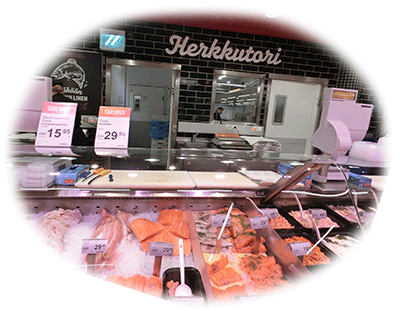
In the fish section of the store, two types of smoked herring were displayed in refrigerated R cases, as shown in the image below. However, I couldn't understand what the difference was. Unfortunately, I failed to take a photo of the raw herring.
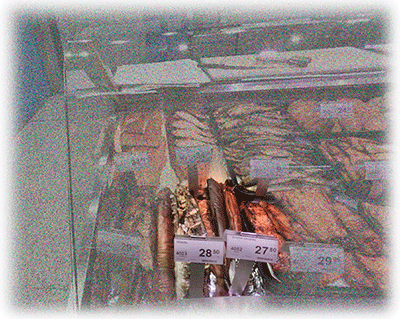
Next, in the square in front of the Helsinki Cathedral, there were two fish store like food stalls, one selling fresh fish and the other specializing in smoked fish.
The fresh fish store, which was equipped with refrigerated cases on the back of a large truck, had a full-fledged selection of products.It was not a simple food stall, but the mobile sales vehicle was a truly magnificent fish store.
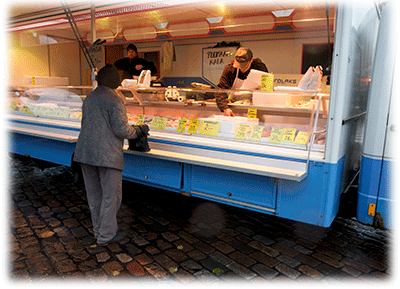
At the store, herring was displayed in a special area in the middle of the display case, and the female customer in the photo who was shopping also appeared to be purchasing herring. There is a raw herring in the rounded highlighted part of the image below.
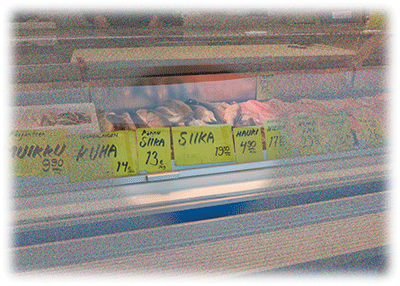
Next is a store specializing in smoked fish. This store was smaller than a fresh fish store, housed in a small trailer, and seemed to be run by a kind-hearted old man. Inside the display case, smoked fish were lined up in rows, and I was really surprised by the wide selection of smoked fish I had never expected. In Japan, these are the mobile sales vans of dried fish stores, and such small stores carry such a large selection of products. It seemed to be a symbolic representation of the fish situation in Finland, a northern European country.

The image below is the smoked herring sold at that store. In Finnish, it said "SUNDOMIN SAVU SIIKA," so I assumed it probably meant "smoked herring from Sandomin."
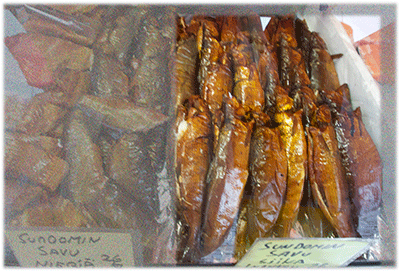
I only stopped in Helsinki for one night on my way back from a visit to Italy, so I haven't been able to investigate the fish situation in much detail. When traveling to Italy, I used Finnair for a direct round trip from Fukuoka, so I ended up flying through Helsinki, the capital of Finland. The trip took 10.5 hours from Fukuoka to Helsinki, 3.5 hours from Helsinki to Rome, and 1 hour from Rome to Venice. Including the transfer time, the actual journey time was 24 hours, and we went directly from Fukuoka to Venice on a very strict schedule. However, on the way back, we departed from Rome, stayed in Helsinki for one night as a stopover, and took a leisurely trip to enjoy some light sightseeing.
The business class meal served on Finnair's return flight from Helsinki to Fukuoka was also filled with herring, which is typical of Finland, so I would like to introduce it as part of the European herring cuisine.
| Finnair's herring dish (explanation of herring only) | |
|---|---|
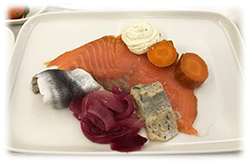 |
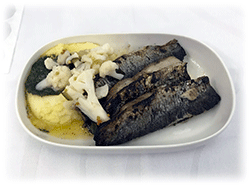 |
| Pickled fish | Seared fish |
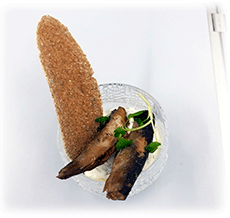 |
 |
| Smoked fish | Marinated fish |
In this way, even though I only spent a short time in Finland, I looked at the role of herring in this country and realized that herring is truly an essential national food for this country.
Herring is said to be comparable to potatoes and wheat in terms of its importance as a food in Europe. Due to its importance and shiny gray skin, herring has long been known as the "silver of the sea.'' Although you might associate herring primarily with a northern European food, it's now widely used in main dishes, sandwiches, and salads all over the world.
Presence of herring in Japan
So, what about the presence and position of herring in Japan? It cannot be said that it is as deeply integrated into the diet as it is in Finland. Speaking of herring in Japan, kazunoko, which is known as the diamond of the sea, is an ingredient that is popular all over the country, but migaki herring cannot be said to be well-established nationwide. For a long time, most kazunoko were imported from foreign countries such as Canada, Alaska, and Russia, and there was a long period when domestically produced kazunoko was almost impossible to obtain. Domestic herring has become easier to obtain in recent years, but prices remain at the highest price range.
Although the best part of kazunoko is the texture of poripori, the price of kazunoko was too high, so kazunoko, an Atlantic herring without the texture of poripori, was imported and sold at a relatively low price. became. How many years has it been since it became like that?
I love kazunoko, and think that it is kazunoko because it has a poripori texture, and that Atlantic herring eggs are not kazunoko because they do not have that texture. By the way, do you know why there is such a difference in texture between Pacific and Atlantic herring, even though it is the same herring? The reason for this is that the Pacific herring first lays its eggs on seaweed such as eelgrass and kelp that grow while being swayed by ocean currents. Therefore, it has a high adhesive strength to prevent it from falling off the seaweed as it sways in the water, and because of this, the eggs have the ability to stick together, giving them a firm feel and a chewy texture. On the other hand, Atlantic herring spawn on rocks or sand, so they don't need to be as sticky as when laying eggs on moving seaweed, and the bonds between eggs are weaker. For this reason, the texture of Atlantic kazunoko is softer than that of Pacific kazunoko.
Based on this difference, the key to determining whether Japan's herring catch will continue to increase steadily in the future is whether an environment is created in the sea around Hokkaido where seaweed such as kelp and eelgrass can grow in abundance. I think this is going to become important. In the past, when close to 1 million tons of herring could be caught, it is said that there was an extraordinary amount of herring that was beyond the standard. However, even though it is true that herring is gradually increasing and the catch is plentiful, it has not reached the explosive momentum it once had. I feel that one of the reasons for this is that the ocean is not as full of seaweed as it was in the past.
However, 2024 is expected to be the best herring catch in decades. Also, fresh herring that can be made into sashimi and sushi is now arriving in Fukuoka, and prices are becoming more reasonable. It seems that the time has finally come when raw herring can be eaten in a variety of dishes, including sashimi and sushi. Below, I would like to write about the raw herring that I obtained this time, with the intention of complementing the content in the previous FISH FOOD TIMES February 2020 issue No. 194.
Herring dishes
In this month's issue, I will try to avoid duplicating the content of February 2020 issue No. 194, but there may be some similarities in the flow of explanations. Please judge for yourself and skip reading that part.
This time, I bought 3 fresh herring with roe and 2 with milt for 300 yen each. I decided to cook not only the herring meat, but also the roe and milt, and try all of them. In particular, the focus this time is on sashimi and sushi. To be honest, I've never eaten raw herring sashimi or sushi myself, and this was my first experience, but I'll explain how I prepared it after some fumbling.
First up was a dish of fish roe and milt. Fish roe is the ovary of herring, which is the raw material for my favorite kazunoko, and although I have eaten processed products made into kazunoko, this was my first experience cooking and eating raw fish roe. As for the milt itself, I had just eaten tiger puffer milt in a hot pot for two months in a row in January and February, and I wanted to see how the taste of tiger puffer milt and herring milt differed.
| Herring roe and milt dish | |
|---|---|
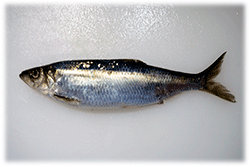 |
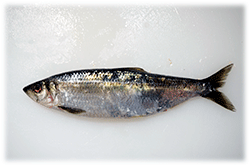 |
| female herring | male herring |
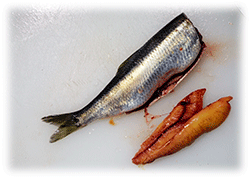 |
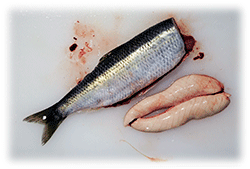 |
| 1,A large and well-developed fish roe appeared. | 1,Milt was also growing significantly. |
 |
|
| 2,All of them are so mature that you can feel they are ripe for eating. | |
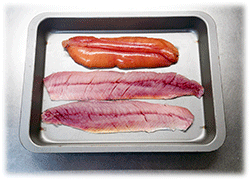 |
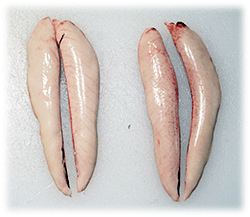 |
| 3,Prepare the three pieces disassembling and roe of one fish. | 3,Poke the large blood vessels in the milt of two herring fish with a toothpick and draw out the blood. Do not touch small blood vessels. |
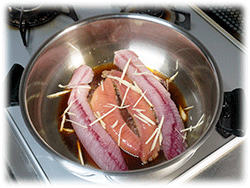 |
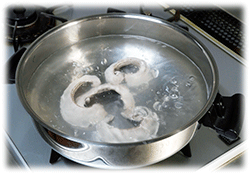 |
| 4,Add the three pieces disassembled fish meat and roe to the boiling liquid over the heat, and sprinkle the ginger on top. | 4,Boil lightly salted water, put the milt in it, and bring it to a full boil. |
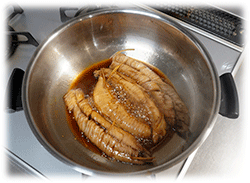 |
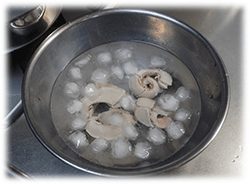 |
| 5,Pour the broth over the top using a ladle while simmering. | 5,Boil for about 10 minutes, then place in ice water to cool thoroughly. |
 |
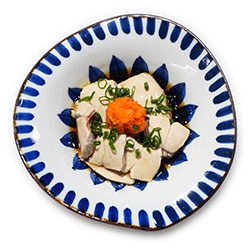 |
| 6,Arrange one half of the three pieces disassembling and half of the roe on a plate for each person, and the boiled fish with herring roe is completed. | 6,Cut the milt into appropriate sizes, sprinkle with ponzu soy sauce, momijioroshi, and chopped green onions to complete the herring with ponzu sauce. |
This was my first time trying both of these dishes, so I would like to write down my impressions. The author found the boiled fish to be "extremely delicious,'' and realized that herring is a truly delicious fish. And Roe thought, "Ah... this is Kazunoko." Also, the boiled roe was so tough that it was difficult to separate it into desired size pieces with chopsticks. This is not simply a matter of the method used when boiling fish, but it seems that the strong adhesive strength of herring roe comes out even when cooked.
Next, the milt with ponzu sauce was surprisingly light and didn't have much flavor. I thought this couldn't compete with the smooth melts-like flavor of that tiger pufferfish milt. As a reflection on this, I boiled it in salt water for about 10 minutes, so maybe I took too long. If the size exceeds 2 kg like tiger puffer, it will weigh 400 g, so if you do not boil it thoroughly for at least 10 minutes beforehand, there is a risk that the center will not be cooked when you put it in the pot. There is. So I boiled the herring milt in the same way, which may have spoiled the taste. However, since this is my first time making it, I would like to confess that I don't really know how to make it taste better or the correct way to do it.
Herring sashimi and sushi
Well, the main purpose of this month's issue was to try eating raw herring. It may be commonplace for people in Hokkaido, but the author, who lives in Fukuoka, has yet to eat herring sashimi or sushi. I was looking forward to this to make up for the lack of content in the February 2020 issue No. 194.
First, let me state the conclusion. Herring is an extremely delicious fish even when eaten raw.
It reminds me of the deliciousness of saury or sardines, but it's different. This herring family includes anchovy, round herring, silver-stripe round herring, etc., and in terms of having many small bones, Slender shad and gizzard shad are also taxonomically similar. However, even among similar species, I thought it was a particularly delicious fish.
However, although it is a very delicious fish, there is one problem. It is the presence of small bones, or more precisely, "epineurium bones." In the previous FISH FOOD TIMES March issue, I selected brushtooth lizardfish, a fish with many small bones, and once again, in the April issue, I used herring with many small bones, so readers may be wondering, ”What's going on ...?" This doesn't have any deep meaning, it just happened to happen, but since this is a continuation of small bones, I would like to explain a little bit about small bones.
Small bones refer to the epineurium bone in the figure below. This refers to the troublesome pin bones that must be pulled out with a boning tool when making raw salmon into sashimi or sushi. But these days, the people at stores that buy raw salmon processed into Trim E may not have to go through the trouble of removing the bones. There are a small number of fish that have this bone called an epineurium bone, and herring is one of them.
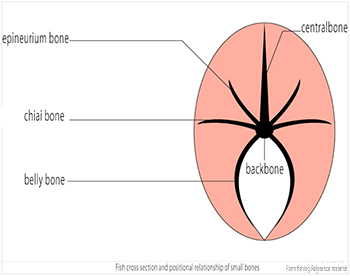
The small bones of herring are at a level where you don't need to be too nervous if you are eating them at home. However, when seafood retailers sell herring as sashimi or sushi products, it seems that they cannot avoid the process of honegiri. Continuing from last month, let's write down the process for making sashimi and sushi, including honegiri.
| Raw herring sashimi and sushi work process | |
|---|---|
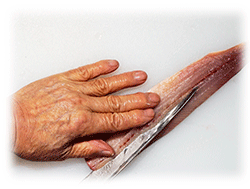 |
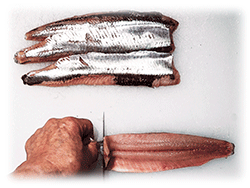 |
| 1,Make a V-shaped incision on the entire chiai bone of the three pieces disassembling using the tip of the yanagiba knife. | 6,Remove all skin from 2 fish. |
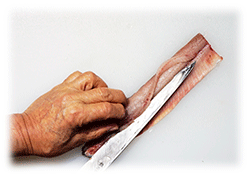 |
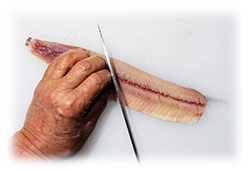 |
| 2,Make a V-shaped cut on the other side as well. The chiai bone is not long, so a shallow cut is sufficient. | 7,Advance the honegiri in a manner that intersects the direction of the belly bone at right angles, leaving the subcutaneous fat layer. |
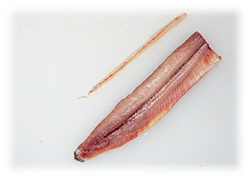 |
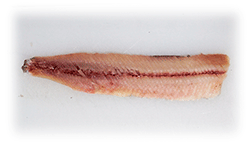 |
| 3,A state in which the chiai bone of the upper body is separated by a V-shaped incision. | 8,The state of the upper body showing the cut after finishing the Honegiri and doing the Honegiri. |
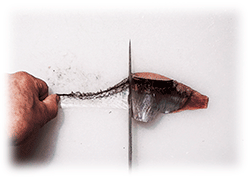 |
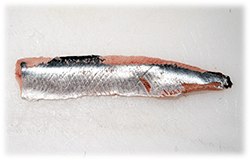 |
| 4,As with horse mackerel, use the spine of a yanagiba knife to remove the skin by pulling it from the head side to the tail side. | 9,Honegiri does not cut into the subcutaneous fat side, and stops the blade just before it does. The edge of the blade was close to the surface under the skin, and traces of it were slightly visible. |
 |
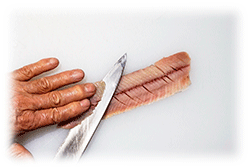 |
| 5,At the end of skinning, press the subcutaneous fat side of the herring with the flat side of the yanagiba and pull the skin with your left hand to remove it. | 10、Furthermore, in order to make this into sashimi and sushi, it is a good idea to use the usutsukuri technique, which includes ensuring the effectiveness of the honegiri. If the usutsukuri is too thin, it will lose its shape, so make it relatively thick. |
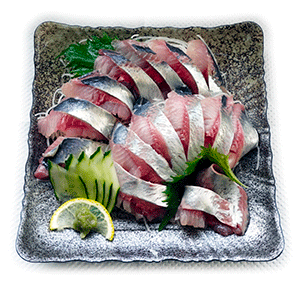 |
|
| Sashimi made by cutting half the body into 7 to 8 pieces using the usutsukuri technique and serving the same amount as one herring. | |
 |
|
| Herring nigiri sushi made with koba using the sogitsukuri technique | |
The raw material cost for these two products is simply fish, each costing 300 yen. Therefore, one piece of sashimi or one piece of sushi costs about 20 yen. The total cost will vary depending on the cost of the container and the amount of ashirai used, but if the cost is 300 yen plus alpha for this volume ( for sushi, the cost of sushi rice is also added ), I think it will be possible to achieve a win-win selling price for both sellers and buyers.
Moreover, raw herring itself is extremely delicious, so there is no doubt that this is a very interesting product for retailers.
We want to take advantage of the fact that herring resources have recovered.
There is no doubt that this season's herring catch will exceed 20,000 tons, but the results will not be known until the fishing season ends in April. However, it seems that herring has continued to be caught well so far, and the presence and position of herring in Japan is likely to change considerably in the future.
As for the timing, this month's issue of FISH FOOD TIMES will be updated on April 1st, and unfortunately this season's herring fishing should have passed its peak. For this reason, it must be said that it is too late to commercialize raw herring into sashimi and sushi to increase sales in the seafood sector. However, the trend of stock recovery of herring is expected to continue steadily every year, and the information I have written so far can be utilized in the sales plan for February and March one year from now.
Readers should keep in mind that the recent recovery of herring stocks is the result of the continuous efforts of those involved in Hokkaido's fishing industry, and is not just a coincidence. .Specifically, the "Japan Sea Herring Resources Increasing Project'' was implemented under the initiative of Hokkaido for 12 years starting in 1996 with the aim of increasing herring resources. The highlight of this project was the release of young fish raised through artificial insemination, and Ishikari Bay herring were used as the parent fish. Even after the project ended in 2007, local fishermen's cooperatives continued to play a central role in releasing young fish. In addition, they have continued to make steady efforts to revive the stock, including implementing voluntary regulations that require fishermen to coarsen the mesh of fishing nets used to catch herring to prevent them from catching small fish.
As a result of such efforts, on March 18, 1999, ``Kuki (school of fish)'' was confirmed off the coast of Rumoi City for the first time in 45 years. However, Kuki was not seen for a while after that, and then Kuki was confirmed for the first time in 10 years in 2009, and since then Kuki has been occurring every year.
In Japan, herring fishing was at its peak from the end of the Meiji era to the Taisho era, when it was common to catch more than 100,000 tons each year, and sometimes as much as 1 million tons, but in 1957, no herring could be caught at all. This seems to have been caused by overfishing, with no regulations in place and herring palaces being built one after another. On the other hand, in Europe, mainly Scandinavia, 2 million tons of Atlantic herring are continuously caught every year. This appears to be due to regulations such as TAC (total allowable catch) being implemented to ensure that resources such as herring do not become permanently depleted.
The herring, said to be a mythical fish, is now being restored as a resource through the efforts of many people. I hope that fish retailers will consider how to position this delicious fish and take full advantage of it, and sell it while emphasizing its value.
| Please access the following URL if you want to secure using SSL. All pages in the site will be secure pages. |
https://secure02.blue.shared-server.net/www.fish-food.co.jp/message english 4.2024.html |
An opinion and the communication are to iinfo@fish food times
Date of updating 1 Apr. 2024
